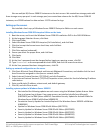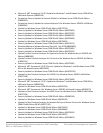
A Principled Technologies test report 17
Virtualized database performance comparison: Dell PowerEdge
R815 vs. IBM System x3850 X5
In the routine Controller(), we changed the string sizes. We added the P option for the 2.5GB database
size. DS2 uses the sizes string to interpret the db_size_str option.
In the class Controller, we changed the arrays MAX_CUSTOMER and MAX_PRODUCT. To each, we
added values specifying the bounds for the customer and product IDs. The Controller() routine uses
these arrays.
We added a command-line parameter for the database name:
—database_name
Editing the workload script - ds2sqlserverfns.cs module
We changed the connection string to increase the number of available connections, to not use the
default system administrator (sa) account, and to include a parameter for the database name. We raised the
available connections limit from the default of 100 to 200 to allow room for experimentation. We created a
user account we called ds2User and used that account.
The ds2connect routine in the ds2sqlserverfns.cs module defines sConnectionString. We used the
following string; the changes we made appear in bold:
string sConnectionString = ―User ID=ds2User;Initial
Catalog=―+dbname+‖;Max Pool Size=200;Connection Timeout=120;Data
Source=― + Controller.target;
Recompiling the ds2sqlserverdriver.exe executable
We recompiled the ds2xdriver.cs and ds2sqlserverfns.cs module in Windows by following the
instructions in the header comments. Because the DS2 instructions were for compiling from the command
line, we used the following steps:
1. Open a command prompt.
2. Use the cd command to change to the directory containing our sources.
3. Run the batch file C:\Program Files\Microsoft Visual Studio 9.0\Common7\Tools\vsvars32.bat. This
sets up the environment variables for us.
4. Execute the following command:
csc /out:ds2sqlserverdriver.exe ds2xdriver.cs ds2sqlserverfns.cs
/d:USE_WIN32_TIMER /d:GEN_PERF_CTRS
Testing procedure
To perform the test, we used a series of batch files. We stored batch files on each client, either under
the C:\ServerShare folder or the C:\ClientShare folder, and we used the PsExec, Plink, and WinSCP utilities to


















